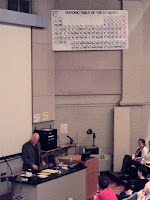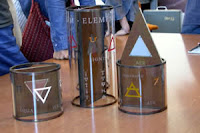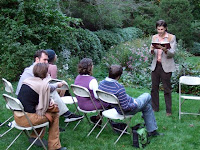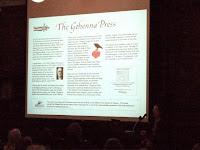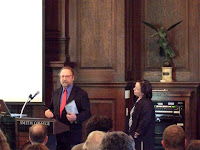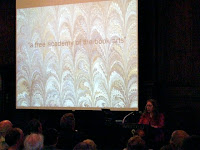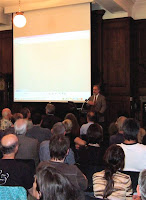
A long-ish entry, but one that, as the opening piece, attempts to address multiple issues simultaneously. Bear with me, or skim freely.
Kristina Tedeschi's
“By hook or by book. Museums 10 aims to draw visitors to the Valley with a range of book-focused events," the first major press coverage of BookMarks, appeared in the
Amherst Bulletin under the dateline of 14 September:
People are "starving" for art, Pelham resident Tony Maroulis says, so Museums10 is going to give it to them - again.
A consortium of 10 area galleries and museums in Amherst, Deerfield, South Hadley and Northampton sharing marketing dollars, Museums10 began in 2005 with the common goals of working together to attract new visitors to the Valley's cultural scene.
The organization's latest endeavor, called "BookMarks: A Celebration of the Art of the Book," kicked off Aug. 25 with an exhibit at Historic Deerfield and will continue through February 2008 with scores of activities, readings, programs and exhibits - all relating to books - spanning the upper Pioneer Valley.
Like an encyclopedia article or a “family car,” such overviews are serviceable and indeed indispensable, but have their inherent limitations.
On the one hand, the article gave prominent coverage to the program: full feature space on the first page of the Arts & Leisure section, with attractive large color photos from three of the first shows (Rosamund Purcell’s
“Bookworm” photographs, and
“Two by Two, Face to Face: A Conversation,” by Brad and Mark Leithauser, both at Mount Holyoke; and
“Ex Libris” [shown here] by Matthew Higgs and Peter Wüthrich, at UMass). The article likewise identified the partners of Museums10 and their mission: “to attract new visitors to the Valley’s cultural scene.” It highlighted their receipt of an impressive $ 50,000 grant from the Massachusetts Cultural Council
John and Abigail Adams Program for Cultural Economic Development and the concurrent attempt “to extend the collaboration” “to other cultural institutions and businesses.”
On the other hand (not surprisingly, perhaps) the focus was almost unrelentlingly on the cultural tourism aspect of the program. The article was in effect built around an interview with Museums10 Project Coordinator (and local
gallery owner)
Tony Maroulis, who is second to none in his passionate
advocacy of the Amherst arts scene, especially vis-à-vis those who see our town as
living in the cultural shadow of
Northampton. As Tony, who used to work at the Emily Dickinson Museum, knows all too well, it is an old controversy, or at least contrast. (Susan Dickinson described nineteenth-century Amherst as a town of
"diversions . . . few and tame,"
"differing markedly from her rival across the river . . . with its wider association and more cosmopolitan traditions." "Northampton—how jealous we were of her!")
Increased cultural tourism translates to a healthier economy, Maroulis says. His interest in the possibilities of the arts feeding area commerce stems from his upbringing in Asbury Park, N.J., a "dead city," he says, which has only recently been revitalized through culture.
"It was the idea that the arts scene could draw people, and bring the town back," that inspires him, he says. "And that's my love of this: Art fueling the economy. That's the most important thing to me."
And although towns and cities in the Pioneer Valley are far from dead, M10 (as Museums10 is nicknamed) saw positive effects here on the local economy last year, Maroulis said, when the organization launched its first series of exhibits, "Go Dutch!," a six-month arts festival that included visual art, music, theater and literature centered around Dutch culture. Some 105,000 people turned out to area museums to take part in the events, marking a 15-percent increase in museum and gallery attendance from the year before. Maroulis noted that, according to his survey of area venues, 40 percent of those visitors stayed overnight, while 60 percent ate at area restaurants and went shopping, boosting the local economy via the towns, cities, museums and galleries offering events, many of which belong operate among the Five Colleges.
"Museums10 is, in many ways, the best town/gown PR you could have," Maroulis says.
My friend Tony cites intriguing figures to support his assertion that last year’s program increased both museum traffic and tourist expenditures in the local hospitality industry. One can only hope that his assumptions are correct. If one may be permitted a modicum of healthy skepticism, however: Given that “Go Dutch!” was a somewhat hastily assembled program driven by a special exhibition at the Eric Carle Museum (to which the other partners adapted themselves as best they could,
faute de mieux), it might be hazardous to extrapolate on the basis of those data.
As any natural or social scientist can tell you, analogy and coincidence are not certain evidence of causality. There are in fact many variables, and unless one can isolate and calculate their individual effects, one would do well to exercise a certain caution. We really do not know whether museum attendance increased due to the intrinsic appeal of the Dutch exhibits (unlikely, in my opinion), the increased publicity on behalf of the museums as a whole (quite possible), both, or neither. And Tony would presumably not take a drop in visitorship at one or all Museums10 institutions as an irrefutable sign that a given year’s program had failed. That said, I fully share his belief in the value of cultural tourism as both an intrinsic and a social good. So, evidently, do the people of Amherst.
Given that the
Bulletin article focused on cultural tourism and economic development, it was all the more surprising that it made no reference to the larger context: Amherst is in the throes of a fiscal crisis and stands on the threshold of adopting a long-overdue
Master Plan required by state law (the last incarnation is over three decades old). The colleges form the stable but narrow employment base of the town, and the students and employees of the three tax-exempt institutions of higher learning also provide most of the revenue for the likewise static retail sector. As a result, residential property taxes have to generate the bulk of funds that support municipal services.
Economic development therefore stands out as a key issue, by virtue of its impact on tax revenues (and all that follows therefrom) and because it brings into high relief conflicting views about the values and character of the town. The
Comprehensive Planning Committee is in the process of sifting through the final iterations of public feedback as it prepares instructions for the consultants preparing the
final draft of the Plan this month.
So far, certain long-standing preferences seem to be confirmed: concentrating development in village centers, so as to prevent sprawl and preserve the historic character, configuration, and landscape of the town; favoring small enterprises and “clean” businesses (including innovative new economic sectors and “hidden tech”) over chain stores and traditional industry.
Cultural tourism is one of the more intriguing issues, which cuts across several of the seven required substantive elements of the Master Plan (notably, and not surprisingly,
Economic Development and
Natural and Cultural Resources).
On the one hand, it is appealing as a source of revenue that does not bring industry or additional construction and population to our town: Like some ancient gods of myth, the sources of our fiscal salvation will visit and then depart, without forcing us entirely to change our ways. On the other hand, cultural tourism will by definition bring visitors—and human and vehicular traffic as well as revenue-boosting expenditures—to Amherst, and that makes some people nervous because they fear it would put our "small-town" character at risk. (We are of course entitled to ask what alternative they would prefer if they are against both development and tourism, and how they propose not only to pay the bills, but also to guarantee affordable housing and social and cultural diversity.) To some extent, cultural tourism is a litmus test for political and economic realism. It could even spur more focused reflection on the need to support public transit and reduce low-occupancy automobile use. On balance, cultural tourism would seem to be one of the simplest and least controversial steps that Amherst and neighboring towns could take in order to revitalize their social life and economy.
It is striking that cultural tourism registered very high not only among the economic-development strategies, but among all questions posed in the random scientific
survey that undergirds the recommendations of the Master Plan: Sixth-highest of all (mean response: 3.95 out of 5), after preservation of environmental resources (top two items), preference for clean industry, affirmation of the centrality of historic resources to the character of the Town, and support for agriculturally based businesses and services as a means of economic development. 73 percent of respondents ranked cultural tourism as "desirable" or "very desirable" as an economic development initiative, whereas only 5 percent called it "undesirable" or "very undesirable."
Public support for the arts as a whole may be softer: "Actively support contemporary cultural life" barely rose about neutral (3.23). Proposals for steps such as creation of an inventory of local cultural organizations or revolving funds to support public art and resident artists have met with a certain measure of resistance (sometimes sharp) in other, less rigorous soundings of public opinion. In these cases, precision is of course crucial. For instance, when respondents were asked to choose their most and least favorite strategies of the Master Plan, they may simply have voted their relative priorities, which is not the same as expressing absolute opposition to a given proposal. They may moreover have had fiscal issues uppermost in mind or assumed that public expenditure was involved: Under the current straitened circumstances, many citizens naturally express a preference for directing funds toward “essential services” such as schools, police, and fire department. Once again, we need to know more. Even the most scientific surveys are fairly blunt instruments in this regard.
On balance, there is reason for optimism, and were one to take a bolder stance, one might even speculate that the strong support for cultural tourism would gradually translate into greater public support, material and moral, for the local individuals and institutions that generate that culture.
[* Full disclosure: The author is Vice Chair of the Amherst Comprehensive Planning Committee, Vice Chair of the Amherst Historical Commission, and Chair of the Natural and Cultural Resources Work Group.]
What is clear is that, if we wish to promote both the arts and cultural tourism, we need to educate the public about what we are up to and why we think it is important.
This brings me back to the starting point of this posting and my questions about the
Bulletin article. After all, although cultural tourism is a worthy goal, we should not forget that the culture is supposed to be the attraction.
Although the article listed sample programs from each of the ten partners and called attention to the three “big weekends”—“Art of the Book” (20-23 September), “Books Out Loud” (12-14 October), and “Books to Blogs and Back” (15-18 November), it actually had surprisingly little to say about content. There was no explanation of why the powerful theme of books (certainly of broader appeal than last year’s “Go Dutch!”) was chosen: no mention of the role of the book in art, the book as art, or the role of the book as a factor in the evolution of civilization.
Although all this will no doubt eventually emerge from the sum of the parts, it would have been nice to get an inkling of the rationale sooner rather than later. To some extent, of course, the responsibility lies with us at Museums10 rather than the press. We may tend to assume rather than explain. Perhaps we need to remind ourselves to talk about both the forest and the trees.
To return, then, to the substance of “BookMarks”:
Six weeks have passed since the opening of the first exhibition,
“The Write Stuff”, at Historic Deerfield, which presents the material culture associated with literacy, from writing desks and chairs to books and inkstands, as the museum’s website puts it. "BookMarks" got a nice initial publicity bounce when the season opened, but most reporting, driven by the press release and the occasional interview, confined itself to generalities or at most the economic development angle.
One hopes that the press coverage will not be limited to overviews such as the one discussed here, admirable as they are. We need follow-up pieces and discusion of individual events and exhibitions. If the public is truly “starving for art”—and especially if it is not—then, an active local cultural journalism will be essential to the promotion of both the arts and the economic activity that they are supposed to generate.
One purpose of this blog is to create a space for just this sort of commentary.





